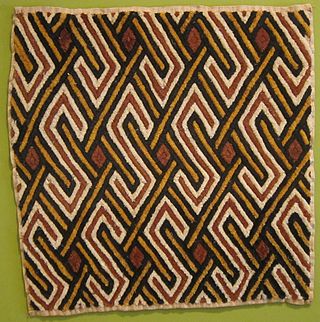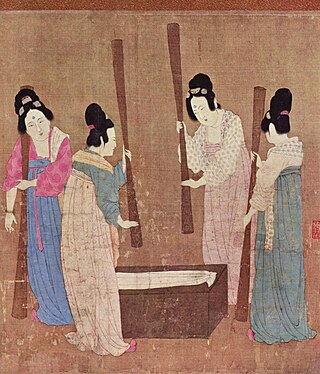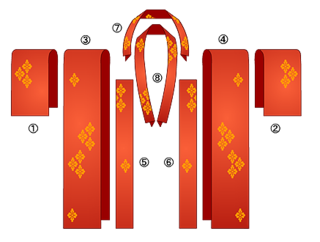Geo. Hattersley was a textile machinery manufacturer from Keighley, West Yorkshire in England, founded in 1789 and responsible for the Hattersley Standard Loom and other types of looms.
Geo. Hattersley was a textile machinery manufacturer from Keighley, West Yorkshire in England, founded in 1789 and responsible for the Hattersley Standard Loom and other types of looms.
Richard Hattersley, the founder of the company, served his apprenticeship at Kirkstall Forge. He set up his own business in 1789 at Stubbings Mill, Airworth, manufacturing nuts, bolts, screws and small parts for textile machines. Although the first loom was produced in 1834, it was never delivered as it was smashed up in transit by a group of handloom weavers of the Luddite persuasion who were fearful for their livelihood. [1] A replacement was eventually delivered. Hattersley's prospered and developed an extensive catalogue, adding new products to their range such as tobacco machines and garden furniture. They also ventured into production and the subsidiary companies have survived where the parent did not. G. Hattersley and Sons Ltd closed in 1983.
Hattersley produced a large range of types of looms [2] over 120 years for all sectors of the market, from the narrow band looms to sheeting looms. At one time, they had about 26 basic models in their catalogue.
In 1867 George Hattersley and Sons created a loom with a dobby head. [1]
In 1908 Hattersley created smallware looms which were suitable for weaving wicks for oil lamps, and the webbing that is used in the automotive industry. To demonstrate this loom, the firm bought the Cabbage Mills and later the Greegate Shed in Keighley where they started production of these products. The firm survives today as Hattersley Aladdin Ltd. [1]
After the recapitalisation boom of 1919 cotton yarn production peaked in 1926, a further investment was sparse. Rayon, artificial silk, was invented in the 1930s in Silsden nearby, and the Hattersley Silk Loom was adapted to weave this new fabric.
The Hattersley Domestic Loom was part of the Hattersley Domestic System that include other machines such as the pirn winder and warping mill. It was a compact machine, combining all the know-how and precision engineering of the nineteenth century with the need for a treadle-operated loom. [3]

The Jacquard machine is a device fitted to a loom that simplifies the process of manufacturing textiles with such complex patterns as brocade, damask and matelassé. The resulting ensemble of the loom and Jacquard machine is then called a Jacquard loom. The machine was patented by Joseph Marie Jacquard in 1804, based on earlier inventions by the Frenchmen Basile Bouchon (1725), Jean Baptiste Falcon (1728), and Jacques Vaucanson (1740). The machine was controlled by a "chain of cards"; a number of punched cards laced together into a continuous sequence. Multiple rows of holes were punched on each card, with one complete card corresponding to one row of the design.

A loom is a device used to weave cloth and tapestry. The basic purpose of any loom is to hold the warp threads under tension to facilitate the interweaving of the weft threads. The precise shape of the loom and its mechanics may vary, but the basic function is the same.

Weaving is a method of textile production in which two distinct sets of yarns or threads are interlaced at right angles to form a fabric or cloth. Other methods are knitting, crocheting, felting, and braiding or plaiting. The longitudinal threads are called the warp and the lateral threads are the weft, woof, or filling. The method in which these threads are interwoven affects the characteristics of the cloth. Cloth is usually woven on a loom, a device that holds the warp threads in place while filling threads are woven through them. A fabric band that meets this definition of cloth can also be made using other methods, including tablet weaving, back strap loom, or other techniques that can be done without looms.
This timeline of clothing and textiles technology covers events relating to fiber and flexible woven material worn on the body. This includes the making, modification, usage, and knowledge of tools, machines, techniques, crafts, and manufacturing systems (technology).

Velvet is a type of woven fabric with a dense, even pile that gives it a distinctive soft feel. Historically, velvet was typically made from silk. Modern velvet can be made from silk, linen, cotton, wool, synthetic fibers, silk-cotton blends, or synthetic-natural fiber blends.

The textile industry is primarily concerned with the design, production and distribution of textiles: yarn, cloth and clothing.

Textile manufacturing or textile engineering is a major industry. It is largely based on the conversion of fibre into yarn, then yarn into fabric. These are then dyed or printed, fabricated into cloth which is then converted into useful goods such as clothing, household items, upholstery and various industrial products.

In India, about 97% of the raw mulberry silk is produced in the Indian states of Karnataka, Andhra Pradesh, Tamil Nadu and West Bengal. Mysore and North Bangalore, the upcoming site of a US$20 million "Silk City", contribute to a majority of silk production. Another emerging silk producer is Tamil Nadu in the place in where mulberry cultivation is concentrated in Salem, Erode and Dharmapuri districts. Hyderabad, Andhra Pradesh and Gobichettipalayam, Tamil Nadu were the first locations to have automated silk reeling units.
The manufacture of textiles is one of the oldest of human technologies. To make textiles, the first requirement is a source of fiber from which a yarn can be made, primarily by spinning. The yarn is processed by knitting or weaving, with color and patterns, which turns it into cloth. The machine used for weaving is the loom. For decoration, the process of coloring yarn or the finished material is dyeing. For more information of the various steps, see textile manufacturing.

African textiles are textiles from various locations across the African continent. Across Africa, there are many distinctive styles, techniques, dyeing methods, and decorative and functional purposes. These textiles hold cultural significance and also have significance as historical documents of African design.

The production of silk originated in Neolithic China within the Yangshao culture. Though it would later reach other places in the world, the art of silk production remained confined to China until the Silk Road opened at 114 BC. Even after trade opened, China maintained a virtual monopoly over silk production for another thousand years. The use of silk within China was not confined to clothing alone, and silk was used for a number of applications, such as writing. Within clothing, the color of silk worn also held social importance, and formed an important guide of social class during the Tang dynasty of China.
The Hattersley loom was developed by George Hattersley and Sons of Keighley, West Yorkshire, England. The company had been started by Richard Hattersley after 1784, with his son, George Hattersley, later entering the business alongside him. The company developed a number of innovative looms, of which the Hattersley Standard Loom – developed in 1921 – was a great success.
Mageba is a producer of textile machinery, based in Bernkastel-Kues, Germany.

Moxon Huddersfield Ltd is a high-end British textile manufacturer of luxury worsted and woollen suiting fabrics. It is located at Yew Tree Mills, Holmbridge, near Holmfirth, Kirklees in Yorkshire.

Bradford Industrial Museum, established 1974 in Moorside Mills, Eccleshill, Bradford, United Kingdom, specializes in relics of local industry, especially printing and textile machinery, kept in working condition for regular demonstrations to the public. There is a Horse Emporium in the old canteen block plus a shop in the mill, and entry is free of charge.

The textiles of Mexico have a long history. The making of fibers, cloth and other textile goods has existed in the country since at least 1400 BCE. Fibers used during the pre-Hispanic period included those from the yucca, palm and maguey plants as well as the use of cotton in the hot lowlands of the south. After the Spanish conquest of the Aztec Empire, the Spanish introduced new fibers such as silk and wool as well as the European foot treadle loom. Clothing styles also changed radically. Fabric was produced exclusively in workshops or in the home until the era of Porfirio Díaz, when the mechanization of weaving was introduced, mostly by the French. Today, fabric, clothes and other textiles are both made by craftsmen and in factories. Handcrafted goods include pre-Hispanic clothing such as huipils and sarapes, which are often embroidered. Clothing, rugs and more are made with natural and naturally dyed fibers. Most handcrafts are produced by indigenous people, whose communities are concentrated in the center and south of the country in states such as Mexico State, Oaxaca and Chiapas. The textile industry remains important to the economy of Mexico although it has suffered a setback due to competition by cheaper goods produced in countries such as China, India and Vietnam.
The textile industry in India, traditionally after agriculture, is the only industry in the country that has generated large-scale employment for both skilled and unskilled labour. The textile industry continues to be the second-largest employment generating sector in India. It offers direct employment to over 35 million people in the country. India is the world's second largest exporter of textiles and clothing, and in the fiscal year 2022, the exports stood at US$44.4 billion. According to the Ministry of Textiles, the share of textiles in total exports during April–July 2010 was 11.04%. During 2009–2010, the Indian textile industry was pegged at US$55 billion, 64% of which services domestic demand. In 2010, there were 2,500 textile weaving factories and 4,135 textile finishing factories in all of India. According to AT Kearney’s ‘Retail Apparel Index’, India was ranked as the fourth most promising market for apparel retailers in 2009.
Tootal is a brand name for a range of British ties, scarves and other garments. The brand is now owned by Coats Viyella. It originates from a textile spinning and manufacturing company established in Manchester in 1799, which later became Tootal Broadhurst Lee, and subsequently Tootal Ltd. The company held patents in crease-resistant fabric.

A tanmono is a bolt of traditional Japanese narrow-loomed cloth. It is used to make traditional Japanese clothes, textile room dividers, sails, and other traditional cloth items.

"Narrow cloth" is cloth of a comparatively narrow width, generally less than a human armspan; precise definitions vary.